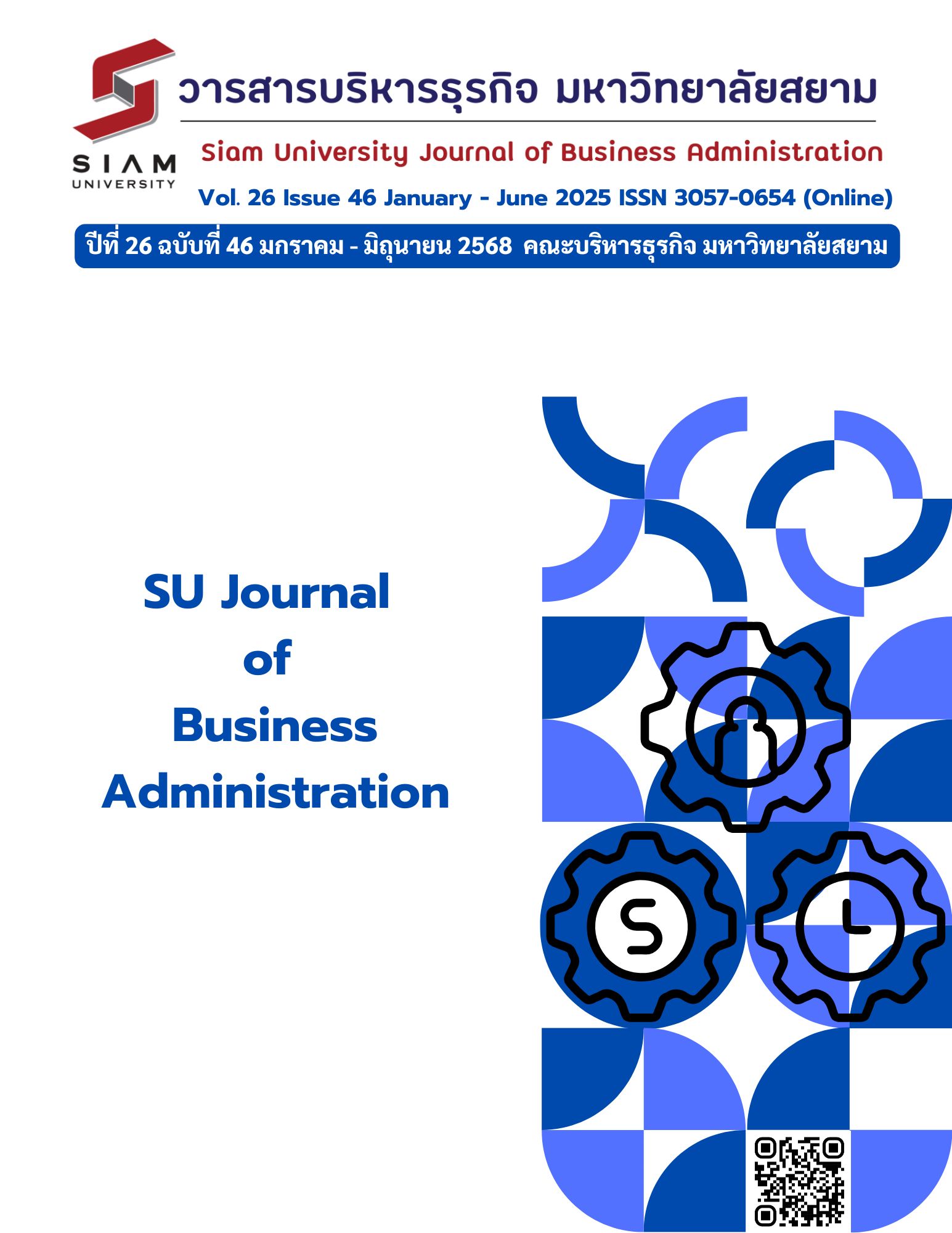Causal Factors Influencing Behavioral Intention to Use the Tourist Attraction Recommendation Application of Thai tourists in Nakhon Ratchasima Province
Keywords:
perceived ease of use, perceived of usefulness, behavioral intention to use, tourist attraction recommendation applicationAbstract
This research aims to analyze causal factor and examine the influential factors of Influencing Behavioral Intention to Use the Tourist Attraction Recommendation Application of Thai tourists in Nakhon Ratchasima Province. The study focuses on a sample group consisting of Thai tourists who have previously visited Nakhon Ratchasima province and have utilized he Tourist Attraction Recommendation Application on various types of mobile devices, including both Android and iOS systems. 150 the samples and data is collected through an online questionnaire distributed via Google Form. The research employs a nonprobability sampling method, specifically snowball sampling, to gather responses. Statistical analysis includes descriptive statistics, confirmatory factor analysis (CFA), and structural equation modeling (SEM).
The results of the study found that; 1) the causal model significantly influences the behavioral intention to use the tourist attraction recommendation application of thai tourists in nakhon ratchasima province, 2) the perceived of usefulness is directly influenced by the perceived ease of use of the tourist attraction recommendation application, 3) the behavioral intention to use the application is directly influenced both the perceived of usefulness and the perceived ease of use, and 4) the behavioral intention to use the application is indirectly influenced through the perceived ease of use to the perceived usefulness of using the tourist attraction recommendation application.
References
กระทรวงการท่องเที่ยวและกีฬา. (2566, 24 เมษายน). ภาครัฐ-เอกชน ร่วมประกาศเจตนารมณ์ เดินหน้าตามแผนพัฒนาการท่องเที่ยวแห่งชาติ ฉบับที่ 3 (พ.ศ.2566 - 2570) ตั้งเป้า สร้างอุตสาหกรรมการท่องเที่ยวที่เน้นคุณค่า และยั่งยืน. เข้าถึงได้จาก https://www.mots.go.th/news/1000397.
ชนนิกานต์ เขียวคล้าย, ฐิติมา นันทะใจ, และ ทิพย์หทัย ทองธรรมชาติ. (2562). การพัฒนาแอปพลิเคชั่นการท่องเที่ยว 5 อำเภอชายแดนจังหวัดตาก. ใน รายงานสืบเนื่องการประชุมวิชาการระดับชาติและนานาชาติ ครั้งที่ 8. (น. 783-792). มหาวิทยาลัยราชภัฏกำแพงเพชร. เข้าถึงได้จาก https://research.kpru.ac.th/research2/pages/filere/1556530234.pdf
ชาญชัย อรรคผาติ และณิชกานต์ เฟื่องชูนุช. (2562). การพัฒนาแอปพลิเคชันแนะนาสถานที่ท่องเที่ยวในกลุ่มจังหวัดนครชัยบุรินทร์โดยใช้เทคโนโลยีภาพเสมือนจริง. ใน รายงานสืบเนื่องการประชุมหาดใหญ่วิชาการระดับชาติและนานาชาติ ครั้งที่ 10. (น. 581-595). สงขลา: มหาวิทยาลัยหาดใหญ่.
ชูศรี วงศ์รัตนะ. (2544). เทคนิคการใช้สถิติเพื่อการวิจัย. (พิมพ์ครั้งที่ 8). กรุงเทพฯ: เทพเนรมิตการพิมพ์.
ณัฐธนินทร์ แสงประเสริฐ, ศรัณย์ธร ศศิธนากรแก้ว, และวราพรรณ อภิศุภะโชค. (2565). ปัจจัยที่มีอิทธิพลต่อการยอมรับและพฤติกรรมการใช้งานแอปพลิเคชันเป๋าตัง. วารสารมหาจุฬานาครทรรศน์, 9(4), 245-259.
ทีเอที รีวิวิ. (2566). สถานการณ์การท่องเที่ยวตลาดในประเทศปี 2565. เข้าถึงได้จาก https://tatreviewmagazine.com/article/situation2022-domestic
นิศากร เถาสมบัติ, เนตรนภา แซ่ตั้ง, และณัฎฐ์ธมน หีบจันทร์กรี. (2563). การพัฒนาแอปพลิเคชันบนสมร์ทโฟน. วารสารก้าวทันโลกวิทยาศาสตร์, 20(1), 34-54.
ปราโมทย์ ลือนาม. (2554). แนวความคิดและวิวัฒนาการของแบบจำลองการยอมรับเทคโนโลยี. วารสารการจัดการสมัยใหม่, 9(1), 9-17.
ปิยภัสสร์ ดรจันแดง และปาริชาต สถาปิตานนท์. (2564). พฤติกรรมและปัจจัยที่ส่งผลต่อการใช้นวัตกรรมแอปพลิเคชันแกร็บ (แกร็บฟู้ด) ในภาวะวิกฤตโควิด-19. วารสารนิเทศศาสตร์, 39(3), 94-112.
ภัทร สูตรสุวรรณ, เดือนเพ็ญ ธีรวรรณวิวัฒน์, และพาชิตชนัต ศิริพานิช. (2564). การศึกษาระบบแนะนำสถานที่ท่องเที่ยวในกรุงเทพฯ และปริมณฑลสำหรับนักท่องเที่ยวต่างชาติ. วารสารสมาคมนักวิจัย, 26(3), 121-139.
มอเตอร์ครอส. (2562). 6 แอปพลิเคชันแนะนำสถานที่ท่องเที่ยวในประเทศไทยที่สายเที่ยวควรมีติดเครื่องไว้. เข้าถึงได้จาก https://www.motocrossmag.co.th/main/6app-tour-thailand/
รังสรรค์ โฉมยา, สมบัติ ท้ายเรือคำ, และเสกสรรค์ ทองคำบรรจง. (2565). วิธีการกำหนดขนาดตัวอย่างสำหรับการวิเคราะห์แบบจำลองสมการโครงสร้างเชิงเส้น. วารสารการวัดผลการศึกษา มหาวิทยาลัยมหาสารคาม, 28(2), 27-40.
รังสินี ชาสุวรรณ, สมนึก เอื้อจิระพงษ์พันธ์, และสุพิศ ฤทธิ์แก้ว. (2565). ศึกษาการยอมรับเทคโนโลยีแอปพลิเคชัันโมบายแบงก์กิ้งของผู้สูงอายุในเขตพื้นที่ภาคใต้ตอนบน. วารสารวิชาการบริหารธุรกิจ สมาคมสถาบันอุุดมศึกษาเอกชนแห่่งประเทศไทยในพระราชููปถัมภ์สมเด็จพระเทพรัตนราชสุุดาฯ สยามบรมราชกุุมารี, 11(1), 159-174.
วรวุฒิ รายาสกุล และโสมฤทัย สุนธยาธร. (2562). ความปลอดภัยและการยอมรับเทคโนโลยีส่งผลต่อการตัดสินใจซื้อตั๋วเครื่องบินผ่านแอพพลิเคชันออนไลน์ของนักท่องเที่ยวชาวไทย. วารสารวิทยาศาสตร์การกีฬาและสุขภาพ, 20(2), 178-192.
วริษฐา สุริยไพฑูรย์. (2560). อิทธิพลของการรับรู้ความมีประโยชน์และความง่ายในการใช้งานที่ส่งผลต่อ ทัศนคติและความตั้งใจซื้อสินค้าแฟชั่นของผู้บริโภคผ่านระบบพาณิชย์บนโทรศัพท์เคลื่อนที่ (วิทยานิพนธ์ปริญญาบริหารธุรกิจมหาบัณฑิต). สงขลา: มหาวิทยาลัยสงขลานครินทร์.
สำนักงานจังหวัดนครราชสีมา. (2566). เป้าหมายการพัฒนาจังหวัดนครราชสีมาระยะ 20 ปี (พ.ศ. 2566-2585). เข้าถึงได้จาก https://www2.nakhonratchasima.go.th/files/com_ebook_strategy/2023-06_16cad18ed19277c.pdf
สุทธิชัย กระจ่างโพธิ์ และธัญนันท์ บุญอยู่. (2566). รูปแบบสมการโครงสร้างของปัจจัยการรับรู้ที่มีผลต่อความตั้งใจใช้ระบบแอปพลิเคชั่นแพทย์ออนไลน์ของประชาชนในกรุงเทพมหานคร. วารสารการบริหารจัดการและนวัตกรรมท้องถิ่น, 5(5), 197-207.
สุรสิทธิ์ อุดมธนวงศ์. (2562). ภาพลักษณ์ตราสินค้าและการยอมรับเทคโนโลยีที่มีอิทธิพลต่อความตั้งใจใช้บริการจองโรงแรมผ่านแอพพลิเคชั่น. วารสารเกษมบัณฑิต, 20(2), 56-67.
Bentler, P. M., & Chou, C. P. (1987). Practical issues in structural modeling. Sociological Methods & Research, 16(1), 78-117.
Cronbach, L. J. (1970). Mental tests and the creation of opportunity. Proceedings of the American Philosophical Society, 114(6), 480-487.
Davis, F. (1985). A technology acceptance model for empirically testing new end-user information systems: theory an results. (Unpublished doctoral dissertation). MIT Sloan School of Management, Massachusetts.
Davis, F., Bagozzi, R., & Warshaw, P. (1989). User acceptance of computer technology: A comparison of two theoretical models. Management Science, 35(8), 982-1003.
George, D., & Mallery, P. (2006). SPSS for Windows step by step: A simple guide and reference 13.0 update. (6th ed.). Boston: Pearson A and B.
Hair, J. F., Black, W. C, Babin, B. J., & Anderson, R. E. (2014). Multivariate data analysis. London: Pearson Education.
Hair, J. F., Black, W. C., Babin, B. J., & Anderson, R. E. (2019). Multivariate data analysis. Hampshire, SP: Cengage Learning EMEA.
Kline, R. B. (2005). Principles and practice of structural equation modeling (2nd ed.). New York: Guilford Publications.
Koçoğlu, C. M. (2021). The evaluation of tourists’ online purchasing behaviors using technology acceptance model (TAM). Journal of Social Sciences of Mus Alparslan University, 9(1), 29-37.
Maravilla Jr, V., & Gantalao, C. S. (2019). E-tourism adoption of the travel agencies in Cebu City, Philippines. Journal of Economics and Business, 2(3), 555-568.
Nunnally, J. C. (1978). An overview of psychological measurement. In Wolman, B.B. (eds.), Clinical Diagnosis of Mental Disorders (pp. 97-146.). Boston, MA: Springer. https://doi.org/10.1007/978-1-4684-2490-4_4
Rovinelli, R. J., & Hambleton, R. K. (1976). On the use of content specialists in the assessment of criterion-referenced test item validity. Retrieved from https://eric.ed.gov/?id=ED121845.
Susanto, E., Hendrayati, H., Rahtomo, R. W., & Prawira, M. F. A. (2022). Adoption of digital payments for travelers at tourism destinations. African Journal of Hospitality, Tourism and Leisure, 11(2), 741-753.
Wicaksono, A., & Maharani, A. (2020). The effect of perceived usefulness and perceived ease of use on the technology acceptance model to use online travel agency. Journal of Business and Management Review, 1(5), 313-328.
Wong, W. H., & Mo, W. Y. (2019). A study of consumer intention of mobile payment in Hong Kong, based on perceived risk, perceived trust, perceived security and technological acceptance model. Journal of Advanced Management Science, 7(2), 33-38.
Zhao, Y., Wang, H., Guo, Z., Huang, M., Pan, Y., & Guo, Y. (2022). Online reservation intention of tourist attractions in the COVID-19 context: An extended technology acceptance model. Sustainability, 14(16), 10395.
Downloads
Published
How to Cite
Issue
Section
License
Copyright (c) 2024 Siam University

This work is licensed under a Creative Commons Attribution-NonCommercial-NoDerivatives 4.0 International License.
ผู้เขียนบทความ และผู้นำส่งบทความ จะต้องเป็นผู้รับผิดชอบในเรื่องลิขสิทธิ์ตามที่กฎหมายบัญญัติไว้ทุกประการ ไม่ว่าจะเป็นในเรื่องของ สิทธิ์แห่งความเป็นเจ้าของบทความ สิทธิ์แห่งการได้มาซึ่งบทความ สิทธิ์ของการได้มาซึ่งข้อมูลที่ปรากฏอยู่ในบทความ สิทธิ์ของการใช้เครื่องมือเพื่อการประมวลผล หรือสิทธิ์อื่นใดอันเกี่ยวข้องกับบทความ วารสาร “วารสารบริหารธุรกิจ มหาวิทยาลัยสยาม เป็นผู้ซึ่งได้รับอนุญาตให้นำบทความออกเผยแพร่โดยสุจริตเท่านั้น สิทธิ์ทั้งปวงอันเกี่ยวข้องกับบทความยังเป็นของเจ้าของสิทธิ์อยู่ สิทธิ์นั้นไม่ได้ถูกถ่ายโอนมาเป็นของวารสารฯ แต่อย่างใด
ข้อความที่ปรากฏอยู่ในบทความนั้น ถือเป็นทัศนะอิสระของผู้เขียน โดยผู้เขียนแต่ละท่านให้การรับรองว่าบทความของตนมิได้ละเมิดลิขสิทธิ์อันเป็นของผู้อื่น วารสารฯ และ ผู้ทรงคุณวุฒิกลั่นกรองบทความ เป็นแต่เพียงผู้ให้ความเห็นเรื่องคุณภาพของเนื้อหา และความเหมาะสมของรูปแบบการนำเสนอเท่านั้น วารสารบริหารธุรกิจ มหาวิทยาลัยสยาม และ ผู้ทรงคุณวุฒิกลั่นกรองบทความ ไม่มีส่วนรับผิดชอบต่อข้อความใดๆ อันเกิดจากทัศนะ และสิทธิ์ในการตีพิมพ์และเผยแพร่ของผู้เขียน






